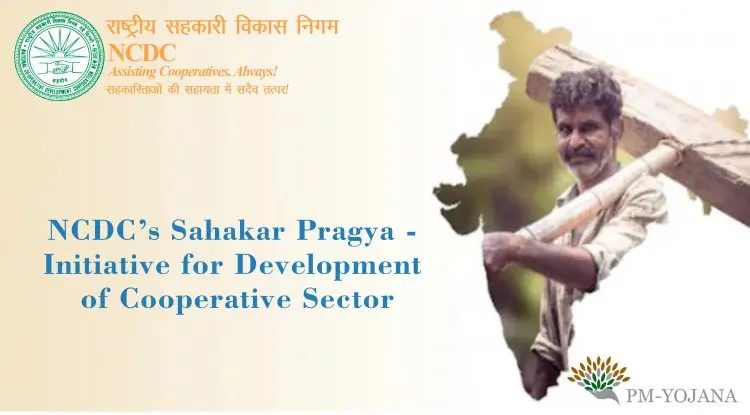NCDC’s Sahakar Pragya - Initiative for Development of Cooperative Sector
Sahakar Pragya initiative mainly aims at strengthening the cooperative sector of our country by imparting knowledge and skills to the rural population of India.

NCDC’s Sahakar Pragya - Initiative for Development of Cooperative Sector
Sahakar Pragya initiative mainly aims at strengthening the cooperative sector of our country by imparting knowledge and skills to the rural population of India.
Sahakar Cooptube NCDC Channel
Recently, the Union Minister of Agriculture & Farmers’ Welfare launched the two initiatives of the National Cooperative Development Corporation (NCDC) - Sahakar Cooptube NCDC Channel and Guidance Videos on ‘Formation and Registration of A Cooperative’.
Key Points
- Sahakar Cooptube NCDC Channel:
- The Channel aims to facilitate involvement of the youth in the cooperative movement.
- Cooperatives lend strength to farmers to minimize risks in agriculture and allied sectors and act as a shield against exploitation.
- The channel will give a boost to Atmanirbhar Bharat Abhiyan under which the government has announced a series of transformative measures and sector specific financial packages to help agriculture.
- The initiatives are steps towards One Nation One Market with the objective for India to become a food factory of the world.
- The Channel aims to facilitate involvement of the youth in the cooperative movement.
- Guidance Videos:
- These have been produced by the NCDC on ‘Formation and Registration of A Cooperative’ for eighteen different states in Hindi and regional languages.
- These would help strengthen and deepen the major initiatives of the government to promote and form 10,000 Farmer-Producer Organisations (FPOs).
- One such initiative is the formation of FPOs under the “One-Product One-District” approach.
National Cooperative Development Corporation
- Formation: NCDC was established by an Act of Parliament in 1963 as a statutory Corporation under the Ministry of Agriculture & Farmers’ Welfare.
- Office: NCDC functions through its Head Office at New Delhi and multiple Regional Offices.
- Functioning:
- The objectives of NCDC are planning and promoting programmes for agricultural produce, foodstuffs, industrial goods, livestock and certain other notified commodities and services on cooperative principles.
- The NCDC has the unique distinction of being the sole statutory organisation functioning as an apex financial and developmental institution exclusively devoted to the cooperative sector.
What is the Sahakar Pragya Initiative?
Sahakar Pragya initiative mainly aims at strengthening the cooperative sector of our country by imparting knowledge and skills to the rural population of India.
Given below are a few major objectives of this initiative:
- 45 new training modules of Sahakar Pragya of NCDC will be training the cooperative societies in rural India
- Farmers will be trained by the primary cooperatives to educate them about minimizing the risk in agricultural activities
- It will also boost the cooperative sector to act as a shield between the farmers and the unscrupulous traders
- Enhancement of NCDC’s training capacity through a network of 18 Regional Training Centres across the country will also be established
Objective of Sahakar Pragya
The training modules under Sahakar Pragya Initiative aim at imparting knowledge as well as organizational skills. They also attempt to prepare the primary cooperative societies all over the country to be able to play a major role in the government’s Atmanirbhar Bharat initiative.
This programme is in terms with the Prime Minister Narendra Modi’s Atmanirbhar Bharat Abhiyan and aims to educate and impart knowledge to the poor farmers of the country and make them self-aware and independent.
The table given below gives the basic details about the Sahakar Pragya initiative which a competitive exam aspirant must be aware of:
| Sahakar Pragya | |
| Aim | Development of Cooperative Sector in India |
| Ministry governing the Initiative | Ministry of Agriculture & Farmers Welfare |
| Launch Date | November 24, 2020 |
| Union Minister for Agriculture (as in 2020) | Mr. Narendra Singh Tomar |
| Other Organisations Involved |
|
- Recent Initiatives:
- Mission Sahakar 22, which aims to double farmers’ income by 2022.
- Scheme on Internship Programme (SIP) named Sahakar Mitra.
Cooperatives
- According to the International Labour Organisation (ILO), a cooperative is an autonomous association of persons united voluntarily to meet their common economic, social and cultural needs and aspirations through a jointly owned and democratically controlled enterprise. E.g. FPOs as cooperatives.
- An FPO, formed by a group of farm producers, is a registered body with producers as shareholders in the organisation.
- It deals with business activities related to the farm produce and it works for the benefit of the member producers.
- Cooperatives in India (Agriculture):
- They largely function as an association of small and marginal farmers and rural poor. They have a huge network of over 8.50 lakh organizations and 290 million members.
- According to the government, cooperatives in India have proven their success in improving the condition of farmers and economic development.
- Provisions of Indian Constitution related to Cooperatives:
- The Constitution (97th Amendment) Act, 2011 added a new Part IXB right after Part IXA (Municipals) regarding the cooperatives working in India.
- The word “cooperatives” was added after “unions and associations” in Article 19(1)(c) under Part III of the Constitution. This enables all the citizens to form cooperatives by giving it the status of fundamental right of citizens.
- A new Article 43B was added in the Directive Principles of State Policy (Part IV) regarding the “promotion of cooperative societies”.







